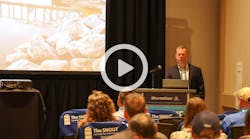While working in the government sector, Duane Burrow became increasingly cognizant of the importance of the long-term impact of a good SWPPP, or stormwater pollution prevention plan. Now in the private sector in Elkhart County, IN, as a registered professional soil scientist and CPESC with his own company, Soil Scientist and Development Planner Inc., Burrow writes SWPPPs, evaluates sites before development, conducts site soil evaluations, writes reports, and assists with site development environmental compliance. With his experience, he says, he brings to the table “knowing the ins and outs of the stormwater management plan application process and issues associated with administrative discretion.” During his time with the government, he saw plans that were not written well for clients. “My objective is to step into that place with plans that actually reflect what the client needs to meet the deadlines associated with erosion control so they have fewer headaches when they are trying to occupy the business,” he says. “The Notice of Termination is supposed to be associated with occupancy of the business.” Burrow believes some people in the erosion control sector don’t understand what is needed to protect the upper watershed aspects of a site so as to not return and rebuild retention areas. One of his favorite projects: helping an engineer design a small 60% impervious site near an Elkhart school. “He was going to be dropping almost 10 acres of watershed directly into a stream with no water pre-treatment,” he says. “I suggested a forebay with channeling to improve the water quality if it goes through the emergency overflow. That one I really like. I drive by it a lot, and it works.”
What He Does Day to Day
Burrow’s days include doing soil work and design work for septic systems as well as erosion control plans for subdivisions under construction. He focuses on getting people in northern Indiana and southern Michigan to move forward with erosion control practices necessary to stay in federal compliance. That may entail hydroseeding or blankets, depending on the time of year.
What Led Him Into This Line of Work
Growing up in Michigan, Burrow found it fascinating to play in the dirt and was amazed that below the sandy soils was what he now knows to be a regolith horizon. “I was amazed at how the soils behaved differently,” he says. In college, he took a number of soils classes, expanding his knowledge of soil varieties. Burrow earned a B.S. in regional planning and resource management from Grand Valley State University and a master’s degree in public affairs from Indiana University. He has worked with the Elkhart County Soil and Water Conservation District as a soil conservationist and urban conservationist, with the St. Joseph Area Plan Commission, and as a municipal separate storm sewer systems manager for the Elkhart County Greater Stormwater District and Department of Public Service division of planning. Burrow established Indiana’s largest multi-jurisdictional National Pollutant Discharge Elimination System permit program for Elkhart County, the cities of Elkhart and Goshen, and the town of Bristol. Burrow also has been a senior planner/floodplain manager and systems administrator for the Elkhart County Department of Public Service division of planning and development. He served an Indiana gubernatorial appointment to the Indiana Registry of Soil Scientist Committee, promulgating rules for the newly established registration of Professional Soil Scientists. Burrow uses his soils background to try to get people to understand soil surveys. “You don’t have to guess what is under the soil,” he says. “You just drill into the horizon and design your project based on what is in existence.”
What He Likes Best About His Work
Burrow enjoys solving clients’ problems. “Because I have a planning background, I can help them with some of the issues associated with development, such as the process of getting permits,” he says.
His Biggest Challenge
Burrow’s biggest challenge is convincing clients that using correct erosion control approaches from the start saves money in the long run. “It is unbelievable how much money they spend after the fact trying to fix all of the problems they created,” he notes. “My biggest frustration when working for the county was trying to get people to understand you can save a lot of headaches at the end of the process.”


